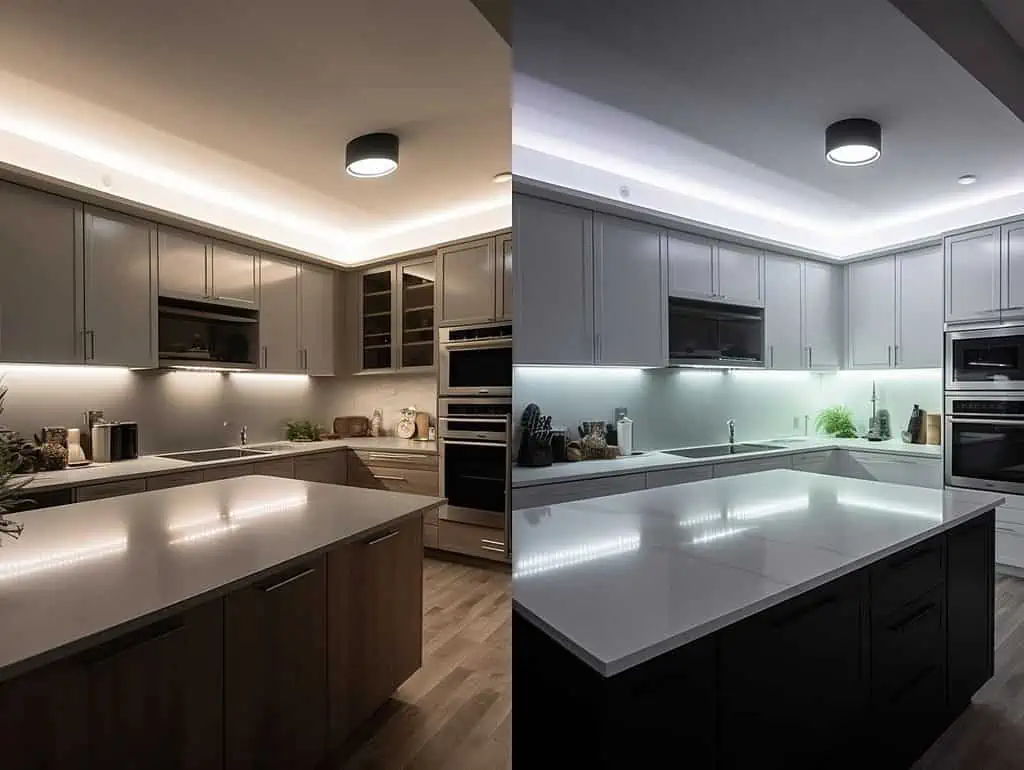Views: 0 Author: Site Editor Publish Time: 2023-10-09 Origin: Site








Color temperature determines a space’s appearance, ambiance, and functionality.
It not only affects our perception of color but also influences our mood and comfort level.
This comprehensive guide will discuss the differences between 6000K and 5000K LED lighting.
The main difference between these two color temperatures is their appearance: 6000K LED lights emit a cooler, more blueish-white light, while 5000K LED lights produce a balanced, neutral white light.
These distinct characteristics affect their suitability for various applications, which we will explore to help you choose the best option for your needs.
Color temperature is a measure that describes the appearance and color of light produced by a light source.
It is expressed in degrees Kelvin (K) and is based on the concept of black-body radiation.
When a theoretical object called a black body (an ideal emitter and absorber of electromagnetic radiation) is heated, it emits visible light at different wavelengths.
As the temperature increases, the color of the light produced shifts from red to yellow, then to white, and finally to blue.
The Kelvin scale is an absolute temperature scale used to define a light source’s color temperature.
The scale starts at absolute zero (0 K) and increases as the temperature rises.
A lower Kelvin value (around 2700K to 3000K) corresponds to warmer, yellowish-white light, often called “soft white.”
As the Kelvin value increases (about 4000K to 5000K), the light appears more neutral and balanced, which is often called “cool white” or “daylight.”
At higher Kelvin values (above 6000K), the light appears bluish-white and is often referred to as “cool daylight” or “cool blue.”

The role of color temperature in lighting applications is essential for creating the desired atmosphere, enhancing visual comfort, and ensuring optimal performance in various settings.
Different color temperatures evoke different emotional responses and affect the functionality of a space.
By understanding the significance of color temperature, one can make informed decisions on selecting the appropriate lighting solution for a specific application.

6000K LED lighting emits a cool white light with a slight blue tint, resembling natural daylight.
This color temperature is often associated with clarity, focus, and productivity.
Bright and high-contrast: 6000K light provides a clean and bright environment, making it easier to see details and perform tasks that require attention to detail.
Slightly bluish tint: The cool white light emitted by 6000K LEDs has a subtle blue hue, which can help create a modern and clean aesthetic in various settings.
Enhances visibility and focus: The brightness and color of 6000K light can promote alertness and concentration, making it ideal for spaces where to focus and productivity are essential.

5000K LED lighting produces a pure white light, which is softer than 6000K but still bright and clear.
This color temperature is often associated with a balanced and comfortable ambiance, making it suitable for various applications.
Pure white light: 5000K LED lights emit a pure, neutral white light, making colors appear more natural and accurate.
Balanced brightness: While still bright, 5000K light is less intense than 6000K, offering a more comfortable illumination level for various settings.
Comfortable and versatile: Due to its neutral tone and balanced brightness, 5000K light is well-suited for various environments and can create a pleasant atmosphere.

6000k vs 5000k
When comparing 6000K and 5000K LED lighting, understanding the differences between these two color temperatures is essential for choosing your specific needs.
While both 6000K and 5000K LED lights are on the cooler end of the color temperature spectrum, they each have distinct characteristics and applications that set them apart.
In the following sections, we’ll explore these differences and provide a comprehensive comparison to help you decide which option best fits your lighting requirements.
Before diving into the detailed comparison table, let’s first briefly examine the key distinctions between 6000K and 5000K LED lighting.
| Feature | 6000K LED Lighting | 5000K LED Lighting |
| Light color | Cool white with blue tint | Pure white |
| Brightness and lumens | Bright and high contrast | Balanced brightness |
| Under cabinet lighting | Enhanced visibility | Comfortable illumination |
| Task lighting | Better focus | Softer, less harsh light |
| Ambient lighting | Cold and sterile | Balanced and inviting |
| Energy efficiency and watts | Similar | Similar |
While both 6000K and 5000K are considered cool white lights, 6000K has a more pronounced blue tint, while 5000K emits a pure white light.
6000K lumens: Generally bright and high contrast
5000K lumens: Balanced brightness, comfortable for various applications
Which is brighter: 6000K or 5000K? Both lights have similar brightness levels, with the main difference being their color temperature.
Under cabinet lighting: 5000K provides comfortable and even illumination, while 6000K enhances visibility and contrast.
Task lighting: 6000K is preferred for tasks requiring high levels of focus and attention, while 5000K provides a softer, less harsh light suitable for general tasks.
Ambient lighting: 5000K offers a more balanced and inviting ambiance, while 6000K can create a cold and sterile atmosphere.
Both 6000K and 5000K LED lights have similar energy efficiency and wattage requirements.
Their primary difference is in their color temperatures and the resulting visual effects.

About Us | Products | News | Cases | Contact Us


